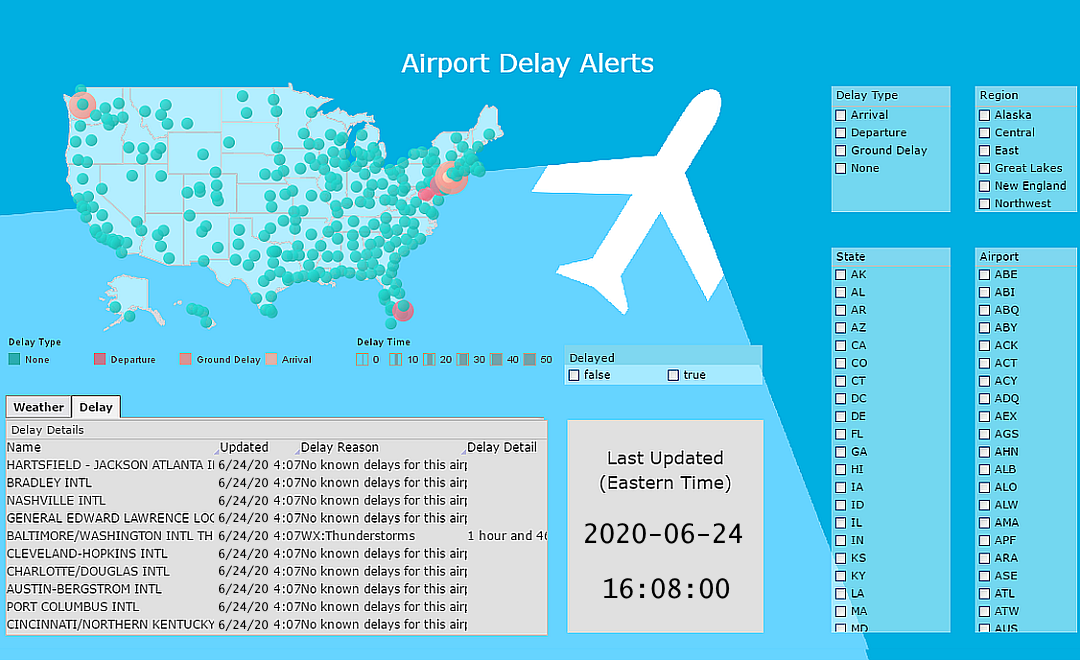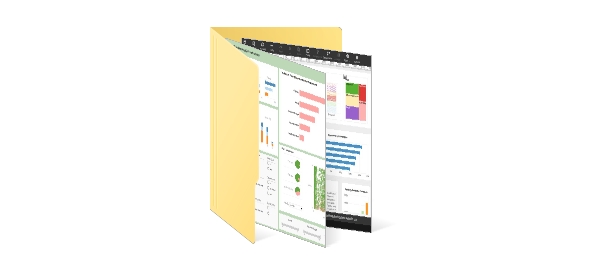Airport Delay Information Dashboard
If you're looking for an Airport Delay Information Dashboard, InetSoft provides the perfect solution. As flights are constantly being delayed and/or changed, it's critical for users to have the most up-to-date information available as any delay in information access can result in missed flight.
At InetSoft, we make sure to provide information that is fast and reliable to the frequent or even casual travelers across the United States. With tools to create a simple and aesthetic visual of airport delays and the weather information of airports across the country, information is constantly being updated automatically from live FAA data for an easy, conveniently amassed view for travelers.
How InetSoft's Interactive Dashboard Software Is Applied to Live Mapping Data:
The Airport Delay Information Dashboard well demonstrates the effective and intuitive nature of InetSoft's dashboard solutions. With an easy-to-use UI, InetSoft's powerful analytical dashboard is a one of a kind solution that brings interactivity, data mashup, dashboards, and reporting all into one software, boosting productivity to all organizations.
One appealing aspect about the particular chart below is the real-time data mashup that presents information through the interactive dashboard. Users can also take control of the different visuals and charts offered, like the map, and use the simple point-and-click environment to focus on specific sets of information, enhancing the analysis process. The tools that are included make it even easier to specify the delay status, delay type, region, state, and airport of airports around the country.
InetSoft's visualization software combines ease of use with detailed tools and features to help users in day-to-day operations, as well as help them keep track of real-time data to respond quickly to any changes.
Capabilities of the InetSoft's Airport Information Dashboard:
- Easy to use, modify, and create charts and visuals
- Leverage user-driven data mashup
- Filter by region, state, airport, delay status and delay type, to display multiple simultaneous results derived from live FAA data
- Views results by delay information, weather information, or map view
Key Airport Delay Metrics Every Manager Should Track
Airports are complex ecosystems where operations, safety, customer experience and commercial performance intersect. To run efficiently and grow sustainably, airports track a wide set of KPIs spanning aeronautical operations, passenger experience, commercial revenue, safety, environmental impact and ground logistics. Below I list the most important metrics, explain what each measures, why it matters, and practical levers airport managers can pull to improve them.
1. Passenger Throughput (Total Pax / Enplanements & Deplanements)
What it is: Total number of passengers processed in a period, commonly split into enplanements (boardings) and deplanements (arrivals).
Why it matters: Core volume metric that drives aeronautical fees, retail sales, parking, and service planning. It’s the primary growth indicator.
How to affect it: Attract new routes and frequencies via airline incentive programs, improve connectivity (better transfer times), invest in marketing and route development, and enhance passenger experience so the airport competes favorably for airlines and travelers.
2. Aircraft Movements (Takeoffs & Landings)
What it is: Number of aircraft operations — arrivals and departures — during a period.
Why it matters: Determines runway capacity usage, air traffic control demands, and aeronautical revenue (landing fees, parking).
How to affect it: Optimize slot allocation, attract airlines with incentives for off-peak movements, improve runway and taxiway efficiency to increase movements per hour, and invest in ground handling to speed turnarounds.
3. On-Time Performance (OTP) & Average Delay
What it is: Percentage of flights departing/arriving within an agreed time window; average minutes of delay per flight.
Why it matters: OTP impacts airline satisfaction, passenger experience, connections and airport reputation.
How to affect it: Coordinate closely with airlines and ATC, streamline ground handling and boarding, reduce bottlenecks at gates, improve snow/ice and contingency plans, and use predictive analytics to anticipate disruptions.
4. Baggage Performance (Mishandled Bags per 1,000)
What it is: Rate of baggage mishandling measured per 1,000 passengers or baggage units.
Why it matters: Directly affects customer satisfaction, costs (compensation, tracking) and airline relations.
How to affect it: Invest in automated baggage sorting and tracking (RFID), train handlers, improve conveyor layout and buffer capacity, and tighten SOPs for transfers and tight connections.
5. Security & Immigration Wait Times
What it is: Average and peak queue times at security checkpoints and immigration control.
Why it matters: Long waits degrade experience and can deter repeat travel or airline scheduling into the airport.
How to affect it: Dynamic staffing based on demand forecasts, phased lane openings, pre-check / fast-track programs, queue management signage, and better passenger flow design.
6. Gate Utilization & Turnaround Time
What it is: Percentage of gate occupancy and average time an aircraft occupies a gate between arrival and departure.
Why it matters: Affects capacity and airline schedules; inefficient gate use reduces how many flights an airport can handle.
How to affect it: Improve ground handling coordination, rationalize gate assignments, adopt pushback and fuelling efficiency standards, and use real-time gate management systems to minimize idle times.
7. Retail & Non-Aeronautical Revenue per Passenger
What it is: Income from concessions, parking, advertising and other services divided by passenger numbers.
Why it matters: Non-aeronautical revenue often funds capital projects and stabilizes finances when aeronautical volumes fluctuate.
How to affect it: Improve concession mix and layout, optimize lease agreements (percentage rent), create targeted promotions, improve wayfinding and dwell time experiences, and expand parking and concierge services.
8. Cost per Passenger (Operating Cost Efficiency)
What it is: Total operating costs divided by passenger throughput.
Why it matters: Key metric for benchmarking efficiency across airports and informing aeronautical charges.
How to affect it: Automate processes, outsource where efficient (e.g., FBO, retail), renegotiate supplier contracts, implement energy-saving measures, and consolidate back-office functions.
9. Cargo Throughput (Freight Tonnage)
What it is: Volume of cargo and mail handled, measured in tonnes.
Why it matters: Cargo is a critical revenue stream for many airports, especially in hub regions or those with strong logistics ecosystems.
How to affect it: Build or optimize cargo facilities, simplify customs and handling, attract integrators (FedEx, DHL), and develop value-added services like cold chain handling.
10. Landside Access & Modal Split
What it is: Measures of how passengers arrive/depart (car, taxi, public transport) and traffic volumes on access roads.
Why it matters: Impacts congestion, parking demand, emissions and first/last mile experience.
How to affect it: Improve public transit links, implement dynamic parking pricing, develop curbside management and ride-hailing zones, and coordinate with local authorities on road improvements.
11. Safety & Incident Rates
What it is: Counts and severity of safety incidents, runway incursions, bird strikes, and workplace accidents.
Why it matters: Safety is non-negotiable; incidents carry human, regulatory and reputational costs.
How to affect it: Invest in safety management systems (SMS), proactive wildlife hazard management, staff training, robust maintenance regimes and a culture of reporting and continuous improvement.
12. Environmental Metrics (Emissions per Pax, Energy Use, Noise Complaints)
What it is: CO₂ or GHG intensity, energy and water consumption per passenger, and community noise/complaint metrics.
Why it matters: Regulatory pressure, community relations and corporate sustainability goals make these central to long-term license to operate.
How to affect it: Electrify ground fleets, adopt renewable energy, optimize HVAC and lighting, implement noise abatement procedures and transparently engage communities around curfews and mitigations.
13. Customer Satisfaction & Complaint Rate (NPS, CSAT)
What it is: Scores from passenger surveys, Net Promoter Score, and formal complaints per 100k passengers.
Why it matters: Drives reputation, airline partnerships and commercial spend.
How to affect it: Close the loop on feedback, train frontline staff, ensure consistent Wi-Fi and amenities, reduce friction points (security, wayfinding) and measure improvements with regular pulse surveys.
14. Resource Utilization (Staff Productivity, Parking Occupancy)
What it is: Metrics showing how efficiently human and physical assets are used.
Why it matters: Improves margins and reduces capital strain.
How to affect it: Use workforce management tools, flexible rostering, cross-train staff, and dynamic space allocation to align supply with demand.
Making Metrics Actionable
Tracking is useful only if tied to ownership, targets and decision rules. A compact executive dashboard should combine a few leading operational indicators (security wait, OTP, gate turnaround), financial KPIs (revenue per pax, cost per pax) and strategic measures (sustainability, NPS). Assign clear owners, set seasonal targets, run daily operational huddles during peaks and monthly performance reviews. Use real-time data where possible (IoT, sensors, APIs with airlines and ground handlers) so interventions are timely. Finally, avoid KPI bloat: focus on the handful that move the needle for capacity, customer experience and revenue.
Airports that treat metrics as the basis for continuous operational improvement — not just reporting — unlock better schedules, happier passengers, higher commercial yield and stronger community trust. Practical gains often come from low-cost process fixes and data-driven staffing rather than big capital projects, so prioritize quick wins while planning strategic investments.




